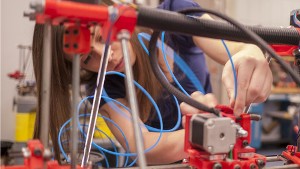Nov 26 2014
A group of mechanical engineering students at Penn State's 3-D Printing Club have successfully created 3D objects using 3D printers.
 Valerie Miller, a student in Penn State's 3-D Printing Club, spools plastic filament into the 3-D printer to begin printing a cookie cutter. Image: Lauren Ingram
Valerie Miller, a student in Penn State's 3-D Printing Club, spools plastic filament into the 3-D printer to begin printing a cookie cutter. Image: Lauren Ingram
Established in 2013, the 3D Printing Club has 30 3D printing hobbyists who are interested in building, printing and modifying 3D printers.
In addition to engineers, the club also includes members from the Smeal College of Business and the College of Agricultural Sciences. The club now has six 3D printers, of which four were manually built by the students.
Apart from the 3D Printing Club, Penn State University conducts a 3D printing class in the College of Engineering and provides printing services to students studying information sciences and technology, mechanical and nuclear engineering, and architecture. Today, 3D printing is playing an important role in automotive, aerospace, food, and medicine sectors.
Wesley Hart, a senior student studying supply chain management, had no clue about 3D printing but after joining the club he believes that 3D printing could help him to develop electric guitars. Hart used 3D printers to develop models of plastic bobbins, which are part of the electric guitar's pickup. Although customized bobbin molds or pre-made bobbins are available, he decided to create his own bobbin shapes by using intricate tapers and curves to produce new sounds.
Valerie Miller, club's treasurer and architectural engineering student, has been using the 3D printers to create innovative shapes of superheroes. Before making the prints, Miller first creates the design by using a 3D modeling software such as Google SketchUp or SolidWorks and then uses a slicing program to format the file into code.
This program splits up the model into digital layers and instructs the nozzle from which the plastic filament is extruded to how and where to move to form each layer. At this junction, Miller selects her plastic and carefully threads the spool inside the printer.
Following this, the nozzle heats and deposits the filament onto a glass sheet, where it hardens quickly. While certain prints can take hours to make, Miller’s cookie cutters take an hour and a half.
I think there's a lot in the near future that will be built with 3D printers — there's even talk about it being as common in your home as a regular printer. That might not be feasible right now, but I think it's definitely something schools should be teaching.
Valerie Miller, Student in Penn State’s 3D Printing Club
Miller, along with other club members, also takes part in 3D printing demonstrations, which are conducted by Penn State University at local schools to raise awareness on 3D printing.